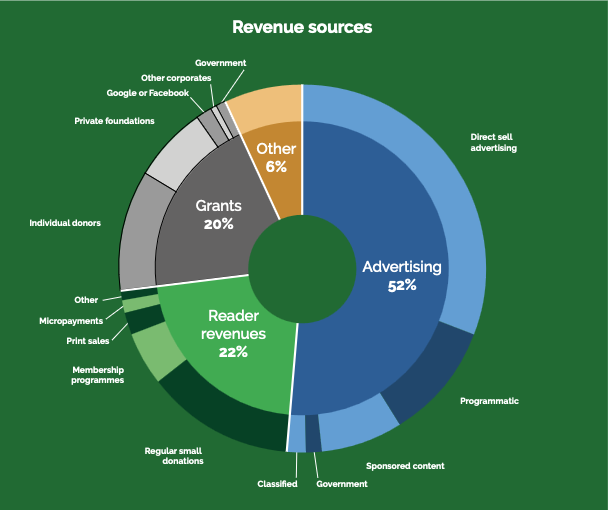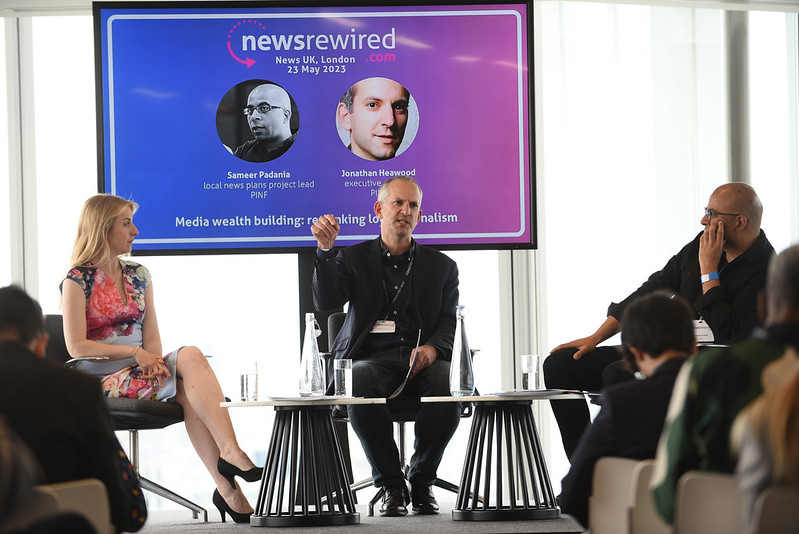
Jonathan Heawood (left) and Sameer Padania (right) discussing PINF's Media Wealth Building project at Newsrewired
Credit: Mousetrap Media/Mark HakanssonIndependent news providers are desperately trying to innovate but are held back by low revenue and limited resources, according to the third annual index of the independent news sector by the Public Independent News Foundation (PINF)
Digital-first, values-driven, cash-strapped
The report, based on a survey of 100 news outlets with a turnover of under £2m, found that on average, revenues are up nearly 20 per cent from last year, but there is a big difference between for-profits and non-profits.
Independent publishers are just about breaking even by earning £89k in revenue based on a new "trimmed mean" methodology, ruling out outliers at both extremes. In the 2022 index, this figure was £74k a year, meaning independent news publishers are finding new monetisation opportunities, but also feeling the pinch of inflation.
Typically, half of the revenue comes from advertising, a fifth from readers and another fifth from grant funding, and the remaining six per cent from "other" sources including, content commissioning, training, syndication, speaking fees, merchandise and events.

Screenshot via PINF Index 2023
Grant funding is down across the sector, but is still important to select news operations. Greater Govanhill, for example, is a Glasgow-based Community Interest Company (CIC) that has an ethical ad policy, making advertising harder to source. Grant funding has plugged the gap, according to founder Rhiannon Davies, speaking at a virtual event about the Index.
[Read more: Govanhill sees journalists back at the heart of the community]
"We operate in a way that is impact and values-driven, so we can go after grant funding typically reserved for charities but also CICs," says Davies.
"Our mission is to do with platforming different voices, challenging negative stereotypes, breaking down cultural barriers and bringing people together. A lot of those aims fit in with foundation grant funding.
"Although a lot of those aims are not seen as journalistic aims, the projects we do to meet those aims are still journalistic."
Independent publishers fork out around £90.5k in outgoings, most of it on staffing for three full-time employees. They also spend out on tech, office space and admin.
Nothing, however, is spent on marketing, which is desperately needed to grow audiences. This was pointed out by two speakers from PINF at our Newsrewired conference: the news industry's marketing spend is between a quarter and half of other B2C sectors.
Speaking about PINF's Media Wealth Building project, director Jonathan Heawood outlined: "It’s unfair to lay all the responsibility on local independent news organisations. Big media, governments and philanthropists are needed. We should support the ecosystem with targeted investment funds."

Mousetrap Media/Mark Hakansson
High impact with few hands
Despite this, independent publishers score themselves 68 out of 100 for having a social impact. Top themes of impact centre around democracy, championing underrepresented voices, housing and planning, environmental issues and public safety.
A good example of this comes from the Bylines Network, a not-for-profit organisation now with 10 regional publications operating as an online citizen journalism outlet.
Louise Houghton, editor of the Yorkshire Bylines, says its participatory model has given a voice to progressive politics.
For example, the publication has spotlighted David Davis, a local MP and the Brexit secretary who famously said Brexit would have no downsides. Yorkshire Bylines has kept a running dossier of more than 1,000 downsides since, which has been referenced anywhere from House of Commons debates to James O’Brien’s talk show on LBC.
"We just want to influence, we don’t care about taking the credit," says Houghton.
Although most publications rely less on volunteers, Bylines Network still needs contributors who can afford to give up their time.
Houghton added that the network would love to launch on TikTok, which is well-suited for pithy, short-form political takes. The network already fetches 8m monthly impressions from Twitter, however, TikTok is a human resourcing problem she cannot yet solve.
Many other independent publications are also seeing an impact of their work, despite shrinking teams doing more full-time hours.
2 things leapt out at me from @PINewsF's index of the independent news sector
— Iona Lawrence / @IonaLawrence@mastodon.social (@ionaflawrence) May 24, 2023
•Publishers are more confident than ever of their social impact
•Reductions in grants & changing consumer behaviour mean some might need to stop print editions or close entirely (cc @stewardingloss) https://t.co/iX7tzJVPB9
Sameer Panadia, local news plans project lead at PINF added at Newsrewired: "Developing countries have been dealing with this viability crisis in local journalism for a while. This is a relatively new problem in the UK."
Newsrooms experiment with creative ways to gauge what younger audiences want and need, or deal with issues of access to technology.
"Local journalists are subsiding their communities because they are working longer hours than they need to for less pay," concludes Padania.
Print’s funeral is not here yet
One publisher breaking the mould is Hackney Citizen, a fortnightly paper that has virtually no online presence or business model. Despite that, it reaps £250k in turnover, the majority from print advertising, as well as £20k a year from large donors.
Print ads have taken a dip post-pandemic, but its statutory notice contract with Hackney Council - now in its third year - is keeping the doors open for now.
Founding editor Keith Magnum is thinking about a digital future with one eye on the relative success of Substack publication The Mill in Manchester and competitor newsletter platforms like Ghost.
"We currently give all our content away on print, so that would be quite a drastic move for us," Magnum says.
He also sees print becoming 'the vinyl of newspapers' as an artefact or super-fan item. As a result, the newspaper is undergoing another redesign to become more artistic to attract both readers and advertisers.
It is a big challenge for a team of four full-time staff all working from home, as the local office lease was cancelled during the pandemic, saving £7k a year in rent.
Free daily newsletter
If you like our news and feature articles, you can sign up to receive our free daily (Mon-Fri) email newsletter (mobile friendly).
Related articles
- What AI can do for your newsroom: tips from Ring Publishing's latest handbook
- Protecting independent journalism, with Lexie Kirkconnell-Kawana of IMPRESS
- Why Australia's bid to make big tech pay for news failed: views from an indie publisher
- How young leaders can shape the future of the media industry
- Covering elections: how to not let politicians steal the narrative









